When is a Velociraptor not a Velociraptor? I would imagine every dinosaur fan is familiar with the famous “swift thief”, and seasoned enthusiasts are probably aware there’s a history of confusion surrounding the dromaeosaur’s identification. V. mongoliensis, the type species of Velociraptor, is currently the primary species recognized under the genus; however it might not be the only one. During the 90s, a larger relative named Deinonychus was briefly suggested as being a species of Velociraptor instead of a separate genus, leading to the fearsome man-sized “Velociraptor antirrhopus” featured in Jurassic Park. While Deinonychus is firmly recognized in literature today as its own genus, though, another discovery described in 2008 revealed that there may be a genuine second Velociraptor species after all.
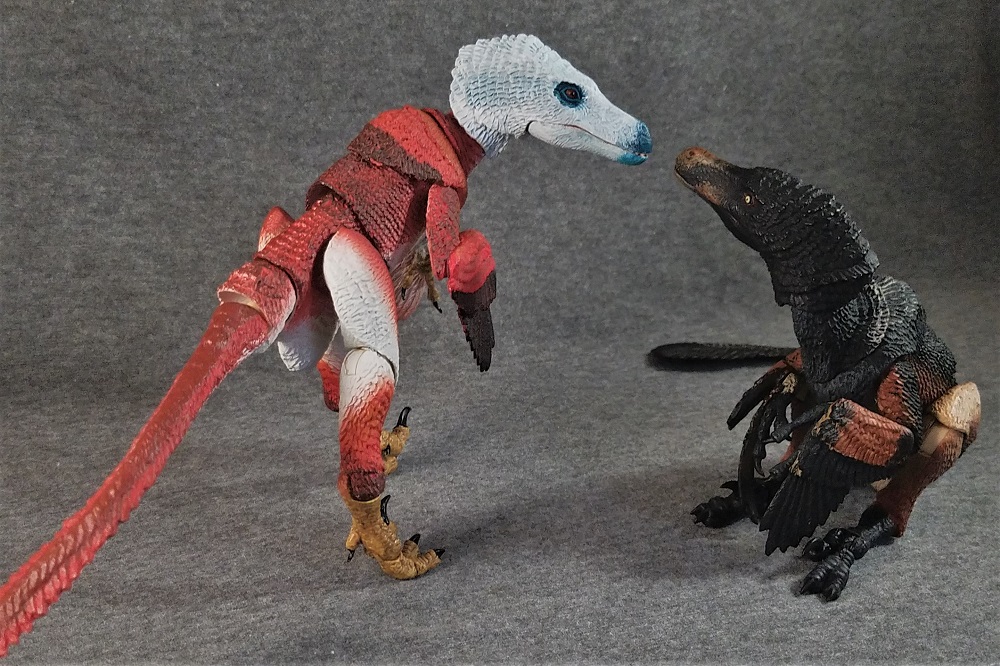
Velociraptor osmolskae (Halzka Osmolska’s swift thief) was described on a couple of skull pieces – not a whole lot, but enough to identify the animal as a velociraptorine theropod, likely within the Velociraptor genus directly. This classification could change in the future, possibly moving under the genus Linheraptor instead; but for now, we have two legitimate “swift thieves”. For David Silva’s Beasts of the Mesozoic action figure line, this meant an additional opportunity to make economic use of the Velociraptor build for some bonus Kickstarter exclusives; thus, between 2018 and 2019, the nearly-unknown second species received its first-ever toy representation. Three total variants were produced, the third of which I have chosen to cover for this review.
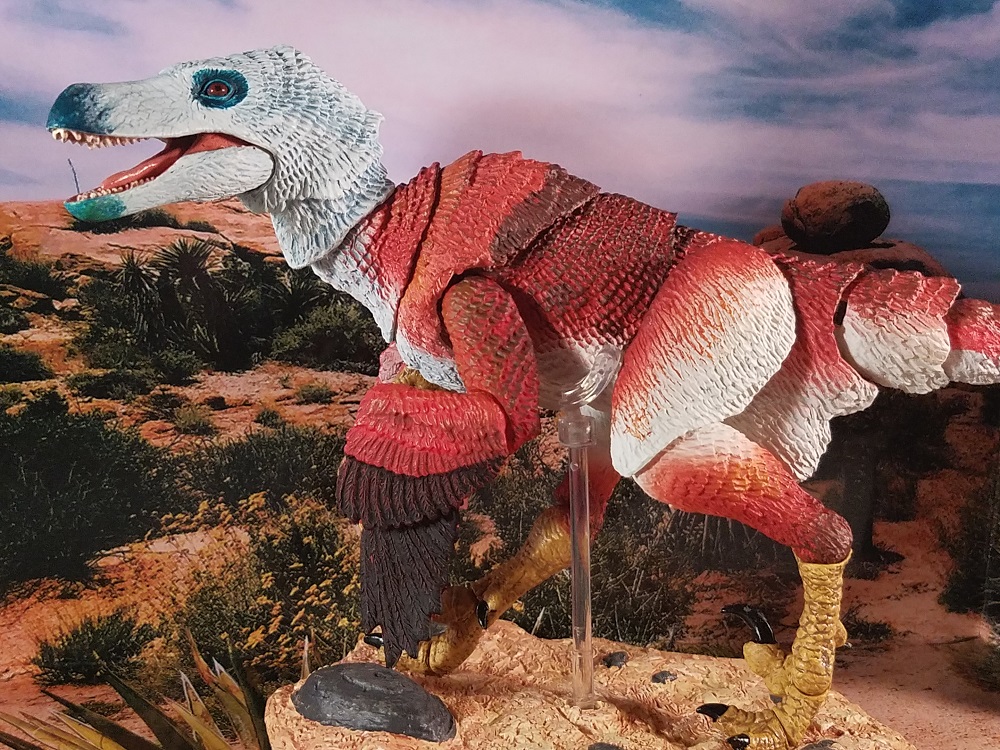
The Beasts of the Mesozoic “Alpha” Velociraptor osmolskae is numbered E1 (between #13 and #14, both of which are V. mongoliensis variant reissues) on the Deluxe Raptor Series checklist. Packaging for the figure is handled in the standard setup for the line, keeping the figure secure while providing scientific facts and attractive display merits on its own. A collectible card, basic assembly instructions, exchangeable toe parts, and a base with stand are included. The figure utilizes the exact same sculpt as the other Velociraptor figures from the Deluxe Raptor Series, measuring about 32 cm (12.5 in) long, straight from nose to tail. For V. osmolskae, estimated in life to measure 1.85 meters in length, the figure technically scales slightly larger than the advertised 1:6 range; it’s a small enough margin that it’s not problematic, though, unless one is very picky.

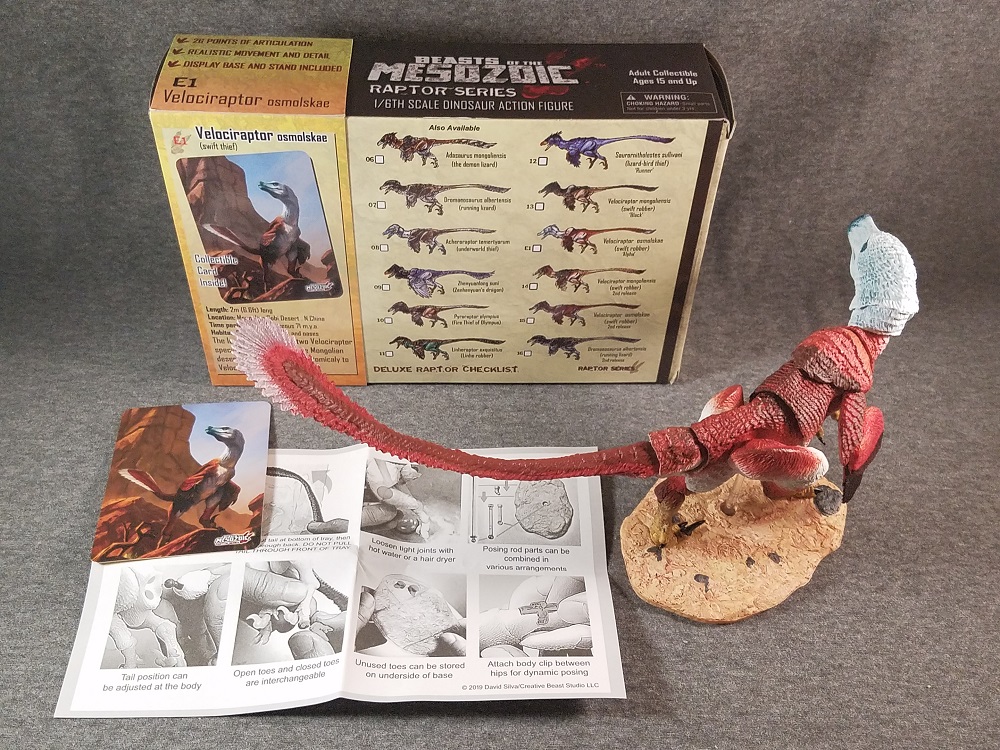
Since V. osmolskae uses the same sculpt as V. mongoliensis in the Raptor Series, what exactly can one use to distinguish the species? …Well, nothing really, to be perfectly honest. Although the traits described in the osmolskae holotype – differences in teeth and in features around the foramina – are distinct enough to label it a unique species, these traits are also subtle enough that, in life, they probably weren’t very noticeable. Nuances in the skull would have likely been obscured by soft tissue, and tooth sizes and counts could vary between individuals. When the first wave of raptor figures was produced, the blue osmolskae release was the sole variant of the Velociraptor sculpt. With over five different variants/reissues in total now, however, the osmolskae label might read a little more superficially.
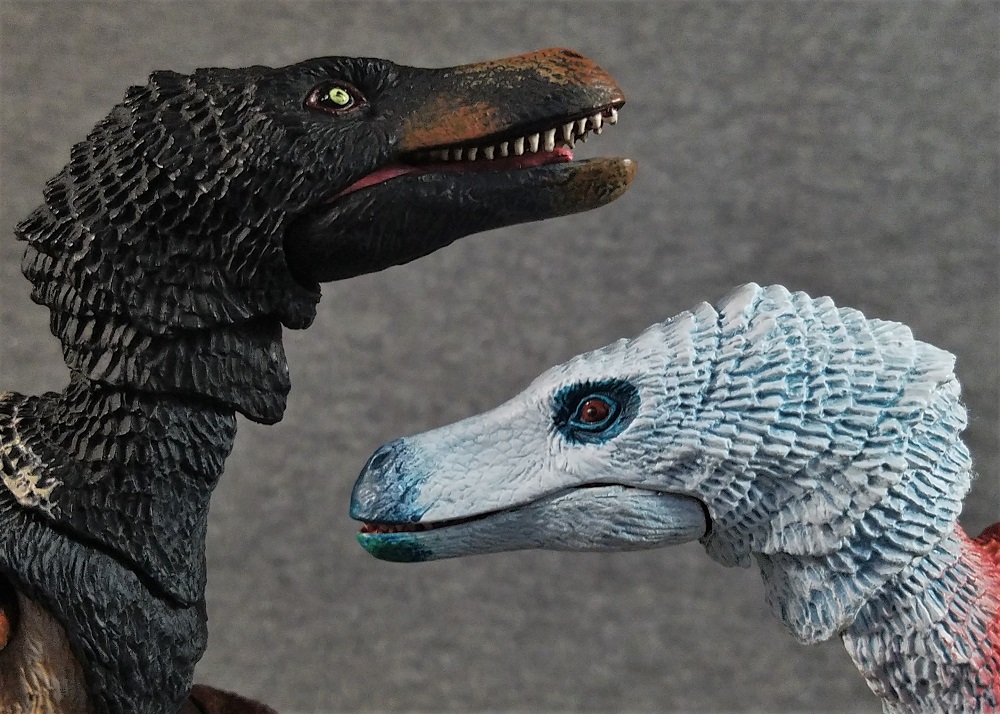
One discrepancy in this particular sculpt is that it has a high tooth count of about 15-16 total in the upper jaw, which is accurate to V. mongoliensis but more than what is estimated from the osmolskae holotype. The teeth in V. osmolskae’s maxilla end sooner than in mongoliensis – although, admittedly, the teeth in the maxilla of the Beasts head sculpt stretch a little farther back than either species, ending nearly underneath the eye. The upper teeth of V. osmolskae should ideally end only about as far back as the teeth sculpted on the lower jaw. Having said all of that, some V. mongoliensis specimens show variation in their skull dimensions, including the position of the last tooth; so perhaps this discrepancy can be waived for sake of reasonable doubt, even if it doesn’t match the current (limited) fossils known.
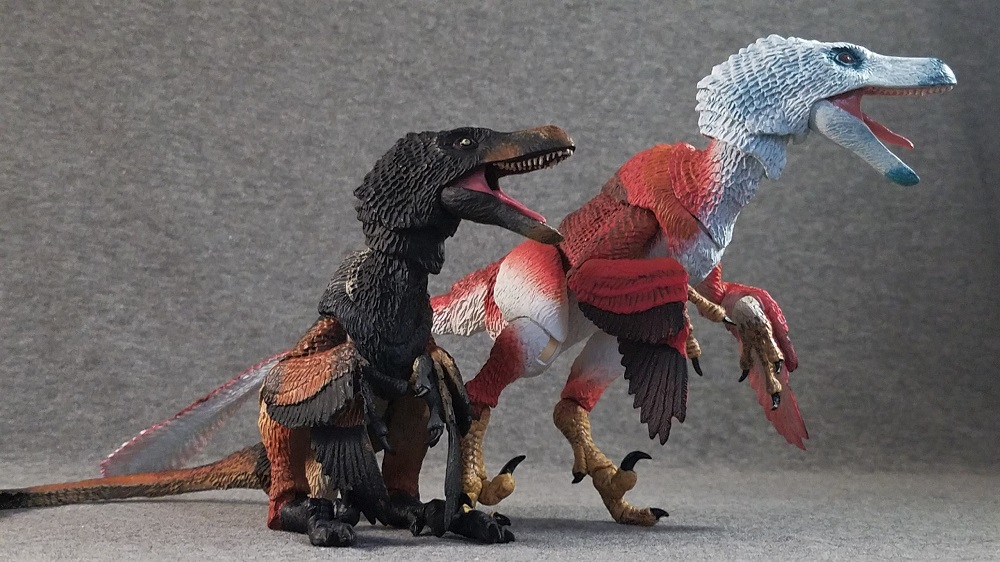
Of course, elsewhere the sculpt is splendid on this figure. Being a reissue of the same sculpt from the original raptor lineup, the “Alpha” figure is very good at matching the proportions known to Velociraptor. The skull is long, narrow, and slightly curved upwards. The limbs are long and slender, as is the substantial tail. The torso is proportioned appropriately to the head and limbs; the hip bone is also large and pronounced, matching the length of the upper length. The majority of the body is coated in short pennaceous feathers, starting on the face and spreading all the way to the tail. Larger flight feathers extend from the arms and in a short fan halfway down the tail. Only the feet and hands are noticeably scaly. One subtle inaccuracy is: although the primaries attach about correctly to the hands and fingers, the 2nd and 3rd digits would most likely have been fused by skin and tissue, not independently mobile as traditionally seen.


Articulation on the figure is also consistent with prior releases, offering a good range of poseability. Marketed as having 26 points of articulation, the total count might be a point or two short depending on one’s perspective; but 20+ points is still substantial. The arms and legs articulate at each of the real-life bone joints, using swivels and hinges where appropriate (the thighs use ball-and-socket mechanisms). The jaw can open widely and shut again, although it might not shut seamlessly depending on the individual figure. Inside the mouth is a tiny ball-jointed tongue for extra measure. The neck has a double ball joint hidden within the “hood” piece, so the neck can extend slightly; a hinge joint attaches the neck to the shoulders, although its motion is very limited. Another ball joint in the midsection allows twisting and turning, complimented by a hinged tail base and ball-jointed tail for dynamic posturing. The majority of the tail is also bendable rubber with a wire, offering good versatility as long as one doesn’t stress it too much; I haven’t heard any stories of the tails breaking yet, but tender love and care is always encouraged.
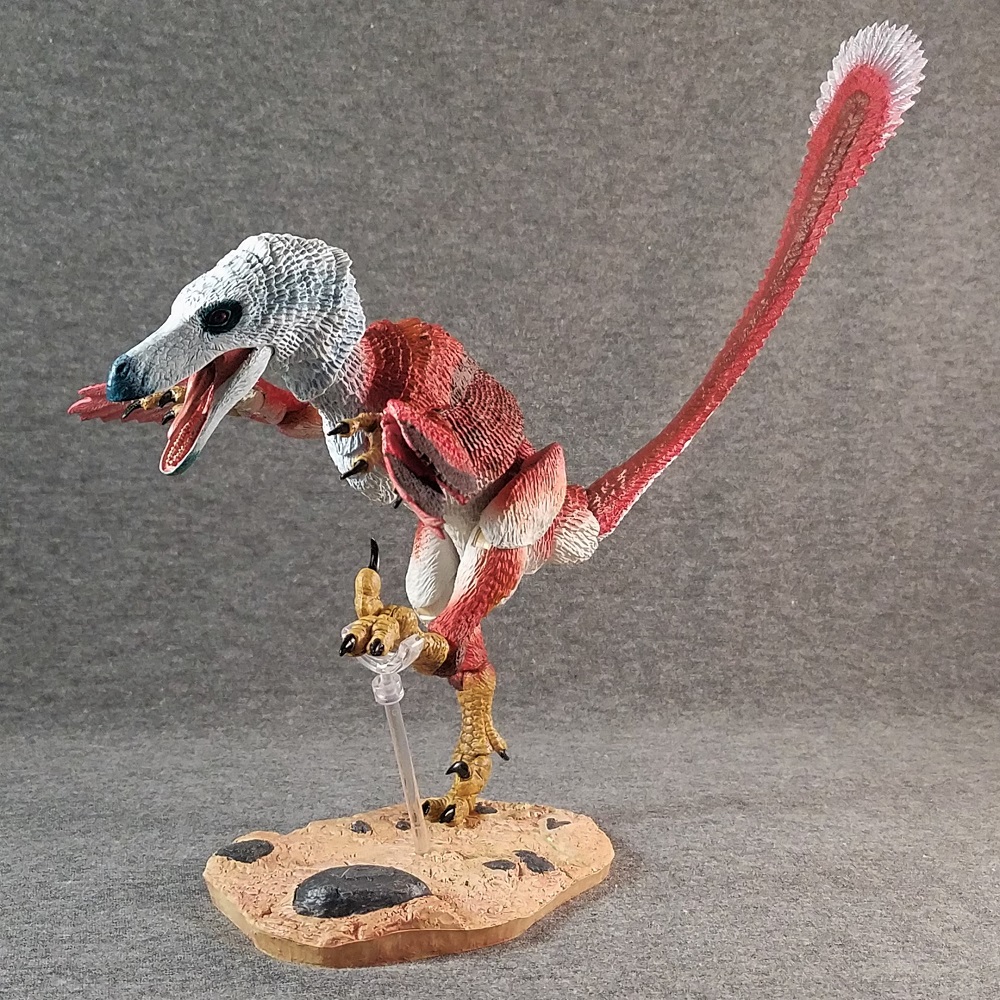
Not all articulation points work as well as intended, mind you. The extra pieces of rubber simulating feathers on the neck and shoulders seem to impede the range of certain adjacent joints, and sometimes it’s hard to position the arms in a manner that doesn’t get in the way of the legs, depending on the poses attempted. One detail I do appreciate is the figure’s ability to sit in a reasonably realistic manner, aided by the tail base’s ability to detach and preposition in a second socket. Another detail I don’t appreciate, however, is the molding of the feet. All figures in the Deluxe raptor series deal with stability issues, and this stems mostly from how dainty the feet are. Granted, dromaeosaurs had small feet in real life; but between the two sets of exchangeable toes, there’s no way to give Velociraptor a neutral standing position. The feet curved in a permanently extended manner like the back foot of a skeletal illustration, and the toes are designed to either pose the foot kicking back or lifted off the ground. Asking for a more static option might sound funny for an articulated figure, but being able to replicate the quieter moments of prehistoric life is a quality I think should be valued in this line of toys, given how many standard dinosaur figurines are often a step away from action poses already. It sounds ironic, but I think the ability of action figure dinosaurs to capture the subjects at rest is one of their greatest strengths.
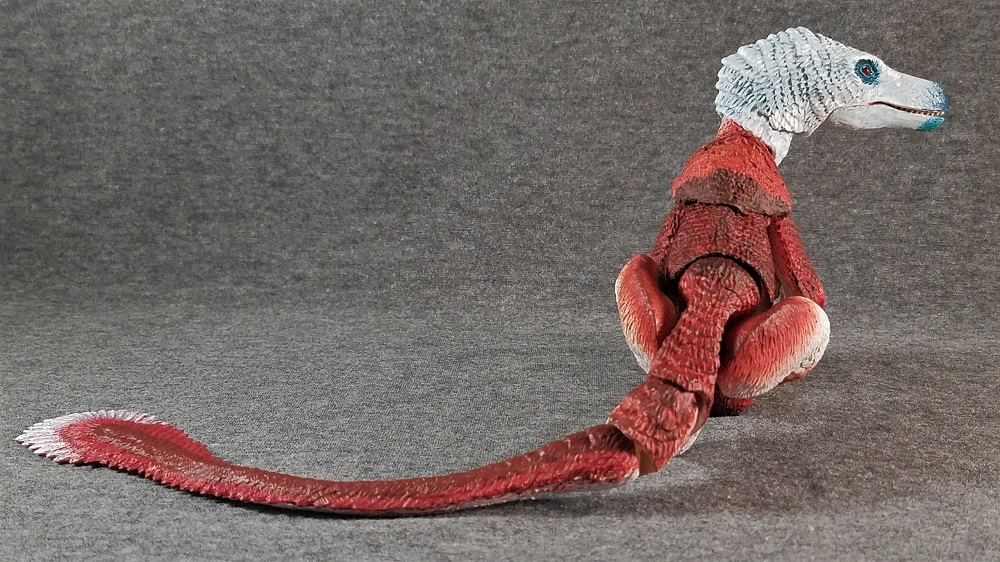
The major feature distinguishing the “Alpha” Velociraptor, of course, is the new color scheme. While the V. mongoliensis releases and reissues had their colorations based on the bearded vulture, the osmolskae variants had more songbird-like colors, resembling blue jays or cardinals. The “Alpha” V. osmolskae, released as a “retailer exclusive”, has a more unique pattern which I think is one of the most attractive of the bunch. The head and underbelly is a blueish-white, with dark aqua-blue highlights around the eyes and tip of the snout. Additional blue wash accentuates the textures of the feathers on the head, fading to a purer white by the point of the belly. On the figure’s back, pure red with ruddy brown/black washes give the raptor a jacketed look, contrasting very nicely with the white head in a manner like some fishing eagles today. The flight feathers on the arms are almost solid black, but red dry-brushing brings out the fine detail of the barbs and blends the wings with the rest of the plumage more. The hands and feet are the same yellow-brown combination seen in other raptor releases, and the claws are all painted a neat glossy black. The eyes are a deep blood red, and the mouth is fleshy pink with individually painted, slop-free teeth. It’s a beautiful paint job altogether, and one that achieves a striking variety of colors while looking very plausible for a living animal of this kind.
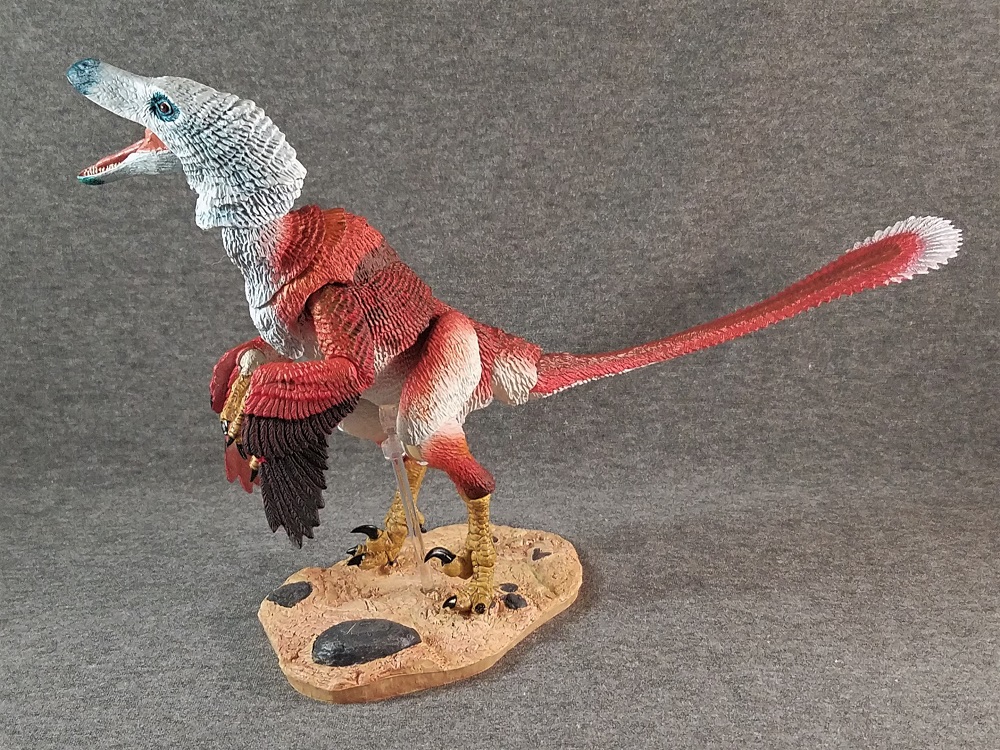

Velociraptor osmolskae isn’t likely to win any awards for fame soon, and the Beasts of the Mesozoic figure is frankly nothing more than a glorified repaint; but, all things considered, it’s still a neat gesture to acknowledge a piece of science many casual (or even experienced) dinosaur fans might not have known about the iconic swift thief theropod. The “Alpha” variant is, in my opinion, particularly attractive as a color variant, and makes a fine addition to one’s pack of articulated raptors. The next time David Silva releases this species, though, it might have to be a Linheraptor repaint. We’ll just have to wait and see!
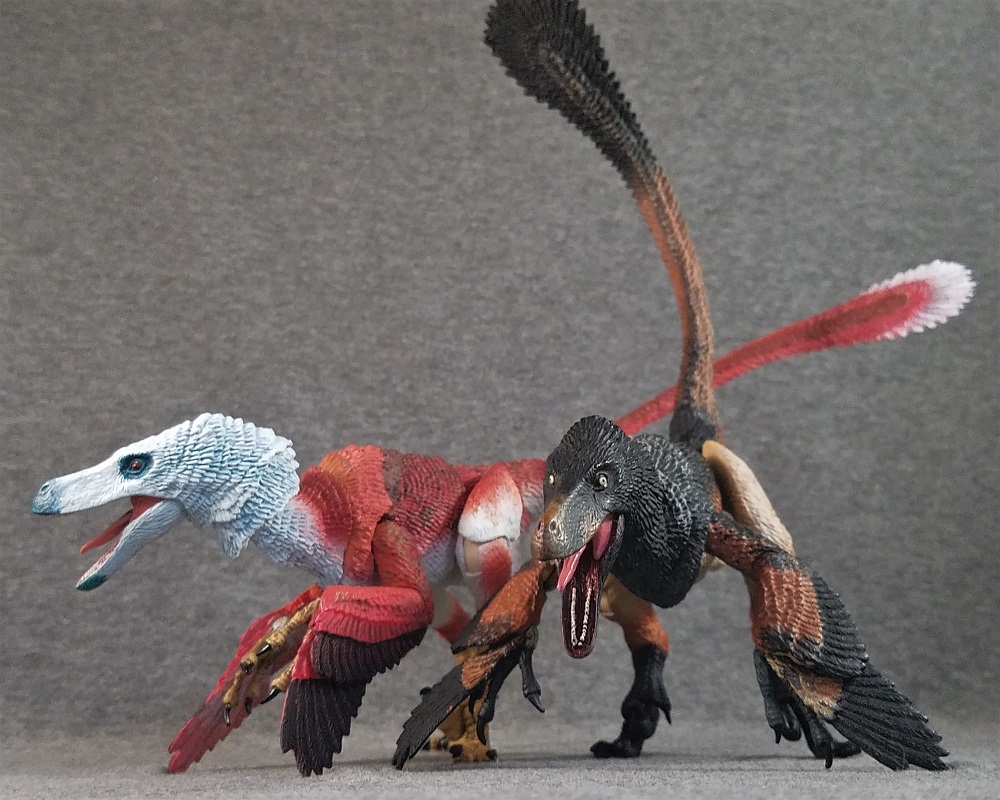
The Alpha raptor and other Beasts of the Mesozoic dinosaurs can be purchased directly from the Creative Beast Studios online shop, as well as through select retailers including Everything Dinosaur and Happy Hen Toys.
Support the Dinosaur Toy Blog by making dino-purchases through these links to Ebay and Amazon. Disclaimer: links to Ebay.com and Amazon.com on the The Dinosaur Toy Blog are often affiliate links, when you make purchases through these links we may make a commission

I skipped this one because I’m kinda all set on Velociraptor, but it’s a very nice repaint, the nicest in my opinion of the three dubbed V. osmolskae.
@Gwangi I think there are just some troll vote casters; they seem to get drowned out eventually.
One of the best paint jobs on any BotM. I don’t understand why the figure is being so poorly rated. I know some people just don’t like the line, and maybe a few are salty about it being a repaint, but there’s no way this is anything less than a 4-5 star figure. I kind of hate that we can see how the votes are allocated. All well, great review, as always!
I agree with your points about being able to pose articulated figures at rest. It’s something I tried doing with a few Hammond Collection figures without any luck.
I love the colors on this one.
Superb colour scheme on this one!